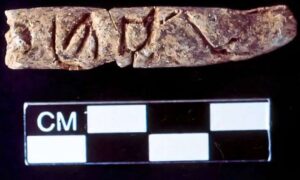Bone fragments found in a German cave reveal that early humans made it to northern Europe thousands of years earlier than we thought. Dating over 45,000 years ago, they are the oldest human remains ever found so far north. This means that early Homo sapiens lived alongside Neanderthals in that region for thousands of years.
Archaeologists discovered the remains in Ilsenhöle cave, in the small town of Ranis, east of Frankfurt. The cave was first excavated in the 1930s. Researchers assumed that the tools discovered there came from Neanderthals.
Now, new excavations exposed the human remains, as well as several other tools. “Our most exciting finding was the identification of new, well-dated Homo sapiens fossils,” co-author Geoff Smith told The Independent. “There were no previously identified human remains from Ranis, so holding these in my hands for the first time was both exciting and nerve-racking.”

Excavating eight meters deep at Ranis required elaborate scaffolding. Photo: Marcel Weiss
Germany was much colder then
The team uncovered 13 Homo sapiens bone fragments dating between 44,000 and 47,500 years ago. Their location suggests that our early ancestors were able to withstand the cold far better than we realized. At that time, the region would have been up to 15˚C colder than today — more akin to Siberia or northern Scandinavia than to Germany.
It had been assumed that cold barred early Homo sapiens from these higher latitudes. “This fundamentally changes our knowledge about the period,” lead author Jean-Jacques Hublin said in a statement. “Homo sapiens reached northwestern Europe long before the Neanderthal’s disappearance in southwestern Europe.”
It is well known that Homo sapiens came to Europe during the Middle-to-Upper Palaeolithic transition. Only a few thousand years later, approximately 40,000 years ago, Neanderthals disappeared. What exactly led to their extinction, and the role that our early predecessors played, has always been a mystery.

The team analyzed over 1,000 animal bones from northern Germany. Photo: Geoff M. Smith
Tools belonged to Homo sapiens, not Neanderthals
The stone artifacts included leaf-shaped stone blades dating from this crossover period. It was always just assumed that Neanderthals made them.
The research team wanted to locate the deposits from the original excavations and verify who made them. The challenge was to excavate the full eight-meter depth and hope that some deposits remained from the 1930s excavations.
“We were fortunate to find a 1.7-meter-thick rock the previous excavators did not get past,” researcher Marcel Weiss said in a statement. “After removing that rock by hand, we finally uncovered the layers and even found human fossils.”
Besides the human bones, thousands of other fragments belonged to animals including reindeer, cave bears, woolly rhinoceroses, and horses.
The cave was primarily used by hyenas and hiberating bears, and only intermittently by early humans. Researchers think that our ancestors may have been drawn to this colder region because of the large herds of prey.






